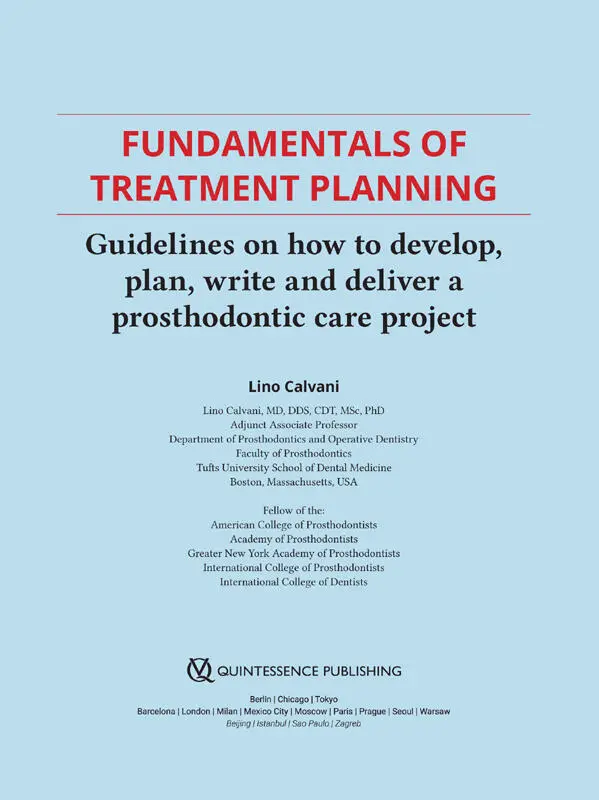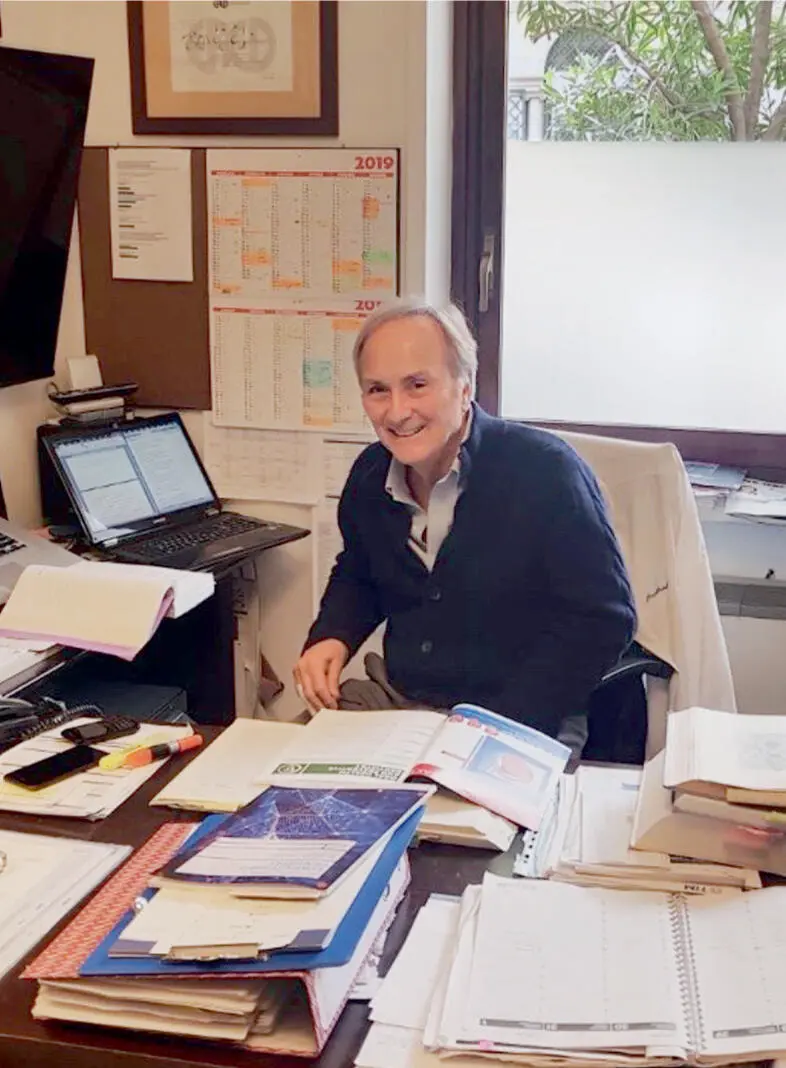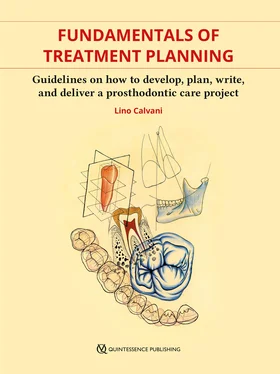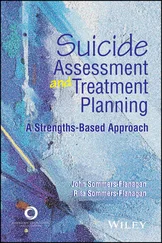FUNDAMENTALS OF TREATMENT PLANNING

Library of Congress Cataloging-in-Publication Data
Names: Calvani, Lino, author.
Title: Fundamentals of treatment planning : guidelines on how to develop, plan, write and deliver a prosthodontics care project / Lino Calvani.
Description: Chicago : Quintessence Publishing Co, Inc, 2020. | Includes bibliographical references and index. | Summary: “This book helps dentists, prosthodontists, and students form and organize their thinking and formulate correct diagnoses and therapies that start with appropriate treatment planning”-- Provided by publisher.
Identifiers: LCCN 2020010451 (print) | LCCN 2020010452 (ebook) | ISBN 9780867157925 (hardcover) | ISBN 9781647240332 (ebook)
Subjects: MESH: Dental Prosthesis | Patient Care Planning | Prosthodontics--methods
Classification: LCC RK651 (print) | LCC RK651 (ebook) | NLM WU 500 | DDC 617.6/92--dc23
LC record available at https://lccn.loc.gov/2020010451
LC ebook record available at https://lccn.loc.gov/2020010452

©2020 Quintessence Publishing Co, Inc
Quintessence Publishing Co, Inc
411 N Raddant Road
Batavia, IL 60510
www.quintpub.com
All rights reserved. This book or any part thereof may not be reproduced, stored in a retrieval system, or transmitted in any form or by any means, electronic, mechanical, photocopying, or otherwise, without prior written permission of the publisher.
Editing: Quintessence Publishing Co Ltd, London, UK
Layout and Production: Quintessenz Verlags-GmbH, Berlin, Germany
Cover illustration: Lino Calvani
“Tristo Discipulo Qui Magister Non Superavit!”
“Bad is the student who won’t do better than his teacher!”
University La Sapienza, Rome, Italy (founded in 1303)

“Great spirits have always encountered violent opposition from mediocre minds. Imagination is more important than knowledge. Knowledge is limited; imagination encircles the world. Any fool can know, but the point is to understand.
I didn’t arrive at my understanding of the fundamental laws of the universe through my rational mind. I have no special talent; I am only passionately curious.
Time is relative and its unique value is given by what we do as it passes.
Only a life lived for others is a life worthwhile.”
Albert Einstein (1879–1955)
Dedication

As science teaches, the concepts expressed in this book were not written as a point of arrival of learning, but rather as a continuous progression of learning. This book is dedicated to all my beloved teachers who inspired me and who still enrich my life as I remind my students that knowledge always follows when you have passion and commitment.
Lino Calvani
Table of Contents
Foreword
Acknowledgments
Organization of the book and how to use it
Prosthodontists: Who we are and what we do
Literature
Chapter one Past, present, and future of treatment planning
The distant past
20th century to the present
‘Hyper-science’ and the future
References
Chapter two Treatment planning management
Some definitions and basic premises
Professionalism: four human factors
| 1. Proper communication and dialogue with the patient
| 2. Motivating patients
| 3. Patient management
| 4. Positive professional characteristics
Priorities
The ideal treatment plan
Compromise
Prosthodontic economics and patient treatment costs
| Affordability of the treatment plan
| The patient’s occupation
| Costs in the face of disease
| Transparency and politeness
Informed consent
| Consent
| Informed consent
| We are not obliged to treat all patients
| In case of emergency
| The use of the informed consent
| Essential aspects of the informed consent document
| Digital technology and informed consent documents
References
Chapter three Prosthodontic tools for treatment planning
How prosthodontists can help their patients
Aims and requirements of all prostheses
Current main prosthodontic tools
Fixed restorations
Removable partial dentures
Complete dentures
Removable overdentures
Full-arch implant-retained fixed prostheses
Bioinformatics and the digital prosthodontics paradigm shift
Computerized chairside and laboratory technologies
| Digital software treatment revolution
| In the clinic
| Digital treatment planning
| Cloud dentistry
| Computer-guided implant-positioning software and hardware
| 3D virtual articulators
| Facially driven dentistry
| Computerized laboratory technologies
Holographic prosthodontics
The day after tomorrow
References
Chapter four Data, findings, and dental semiotics
Data
Findings
| Symptoms
| Signs
| Simultaneous symptoms and signs
| Main symptoms and signs in dental medicine
Semiotics and dental semiotics
References
Chapter five The first visit – diagnostics
Approaching and meeting the patient
| Professionalism
| Attitude
| Kindness
| Empathy
Where we meet our patients for the first visit
How to communicate with patients during the first visit
Professional office techniques to gather information
| Emergency examination
| Screening examination
| Comprehensive examination
The first professional appraisal
The important basic information
Chief complaint
| The histories
Clinical examinations
| Radiographic examinations
References
Chapter six Diagnosis and prognosis
Diagnosis
| Differential diagnosis
Prognosis
| New predictive technologies
| Prosthodontic prognoses
References
Chapter seven Physical examination – Part I: extraoral examination
Clinician qualities
Steps of the physical examination
| Prepare the environment
| Make the patient feel at ease
| Check the evaluation questionnaire with the patient
Physical examination checklist
Physical inspection of the body, auscultation, and odor examination
| General appearance
| Body posture
| Movements and muscle coordination
| Nails, skin, and hair
| Breathing patterns
| Odors
| Speaking ability
| Speech peculiarities
| Understanding ability
| Vital statistics
Head and neck inspection – examination
| Face
Читать дальше
















